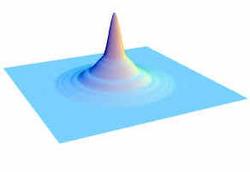Bose-Einstein Condensate in Hydrogen

Concluding a quest that lasted 20 years, a team of researchers has teased a sample of hydrogen gas into forming a Bose-Einstein condensate (BEC), a form of matter in which all of the atoms occupy the same quantum state. They report their finding in the 2 November issue of PRL. Since 1995, many groups have achieved BECs in dilute gases of alkali metal atoms, such as rubidium, but the hydrogen BEC contained more atoms than any other and should also allow for more precise comparisons with theory.
Thomas Greytak and Daniel Kleppner, leaders of a group at the Massachusetts Institute of Technology, began their quest in 1978 after theorists predicted that spin-polarized hydrogen (hydrogen atoms with all of the quantum spins aligned) would be a good candidate for BEC formation. Originally they polarized the gas by letting it flow into a strong magnetic field that attracted atoms with spins oriented antiparallel to the field and repelled the others. But the group found that with this method they could not reach the extremely low temperatures needed for a BEC. The atoms could not be cooled below about 100 mK because of collisions with the walls of the container. They solved this problem by reconfiguring the field to be weaker in the center, so that atoms with spins parallel to the field collected there, in a magnetic “trap.” Gradually reducing the field strength at the edge of the trap made it “shallower” and allowed higher energy atoms to escape, because their thermal energy was sufficient to overcome the weaker trapping force. This process left the remaining atoms with temperatures as low as 100 µK. Many groups subsequently adopted this “evaporative cooling” approach in their BEC cooling schemes.
To reach their goal, the MIT group added a final cooling step similar to that used by the other groups: They applied a radio-frequency magnetic field tuned to flip the spins of the most energetic remaining hydrogen atoms. With spins flipped, they were immediately attracted to the outer, stronger-field regions, and this additional cooling allowed the condensate to form at a temperature of 50 µK . To detect the BEC, which remained mixed with normal hydrogen atoms, the team observed the fluorescence excited by a laser of variable wavelength. Atoms in the denser BEC have a slightly different spectrum of energy levels from those of the normal gas, so their fluorescence peaks at a different wavelength. From the peak shift, the team calculated that the condensate contained about one billion atoms, at least ten times what previous groups had achieved with alkali metals.
In addition to the fundamental physics of this rare state of matter, physicists are pondering ways to apply BECs to practical ends. Last year a different group at MIT constructed a rudimentary “atom laser” from a sodium BEC. “It is always interesting to have a new BEC system since there have been differences between almost all that we have yet seen,” says Carl Wieman of the University of Colorado in Boulder. “Our hope is that looking at a new system in a new way will lead to new physics,” adds Kleppner.
–Arthur Robinson
Arthur Robinson is a science writer and editor.


